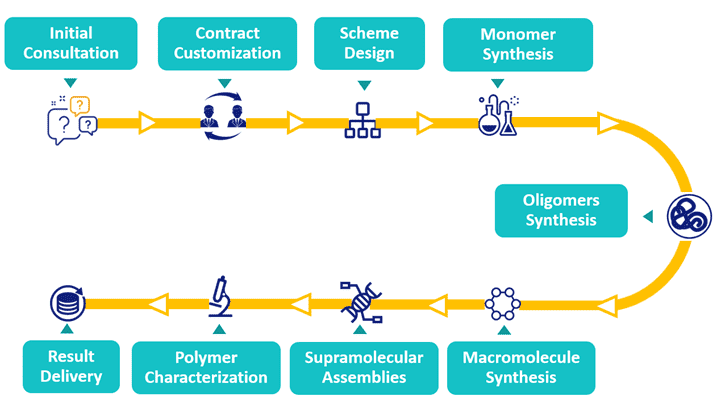Virus-polymer conjugates refer to the attachment or growth of synthetic polymers on or within viral protein capsids, which hold promise in drug-delivery, gene-therapy and material fabrication. BOC Sciences provides an integrated platform with polymers and monomers development and manufacturing capabilities from preclinical to commercial stages. We are striving to offer a wide range of services including polymer synthesis, polymer characterization, polymer purification and isolation, and polymer bioconjugation and side/end group modification.
Virus-like particles (VLPs) are emerging tools for nanomedicine because of their monodispersity, well-defined shapes and sizes, and precise placement of chemical handles for conjugation of drugs, targeting ligands, and polymers. Noninfectious VLPs have been utilized for tumor targeting, drug delivery, immunotherapy, and imaging, while gene-delivery vectors have also been extensively researched. However, since VLPs stimulate innate and humoral immunere sponses, overcoming immune surveillance remains a challenge. For example, studies using adeno-associated virus have shown that repeat injections limit efficacy and can result in adverse inflammatory immune responses. These effects can be mitigated by covalent coupling of polymers to the capsid surface. In recent years, the idea of attaching or growing synthetic polymers onto or within viral protein capsids has stimulated research suggesting these virus-polymer conjugates hold promise in drug delivery, gene-therapy, and material fabrication.
 J. Am. Chem. Soc. 2017, 139(9): 3312-3315.
J. Am. Chem. Soc. 2017, 139(9): 3312-3315.
Viruses-polymer conjugate materials have shown advanced properties that arise from inheriting the unique nature of each component virus and polymer and the covalent chemistry that allows controllable and stable integration of functional molecules. Indeed, researchers have found that by integrating VLPs with polymers they can induce significant changes in their physical properties. That is, polymerization plays an important role in enhancing thermal stability of virus particles, especially for secondary protein structures, while higher order protein structural stability is further enhanced by adopting acrosslinking strategy. Moreover, another feature that virus-polymer hybrids possess are controllable bio-interactions. A benefit tousing VLPs over soft polymer and heterogeneous platforms is that the locations of reactive residues are known to atomic precision, allowing defined spatial organization of substituents on the surface.
Viral capsids are already ideally constructed nanomaterials for medical applications as they are intrinsically capable of safely holding genomic material and transporting it in hostile environments. Another attractive feature of viral templates is their innate monodispersity in size and volume. With a precise volume, viral capsid allows for more precise control over the stoichiometry in potential catalytic reactions, moreprecise control of dosage in drug delivery, etc. Furthermore, viral nanoparticles are also biodegradable, which provides VLPs a distinct advantage over non-biodegradable hard materials as protein capsids are well tolerated and, when appropriately functionalized, have clinically useful circulatory half-lives.

Grafting to Strategies of Viruses-Polymer Conjugates
Grafting to approaches are mostly used in polymer attachments to the outer surfaces of VLPs, that is, long polymer chains are directly attached to the surface. Currently, conjugation on surface-exposed lysines or tyrosine residues is more commonly used. Armed with rich experience in polymer modification, BOC Sciences' virus-polymer conjugate technology mainly supports customized services for phage Qβ, phage MS2, and tobacco mosaic virus (TMV). We enable customers to benefit from our tailored methods that balance their needs in terms of speed and cost.
Grafting from Strategies of Viruses-Polymer Conjugates
To increase the polymer yield on the surface as well as obtain better control over the polymerization, a grafting from strategy has been employed using small-molecule initiators that can be loaded more densely on the surface. The initiators are then used in a follow up polymerization step that, in principle, forms a well-controlled, synthetic shell across the exterior surface. Furthermore, the grafting from route aims to provide a more delicate manipulation of the composition and properties of attached polymers, as well as retention of the uniform size and shape of VLPs. With our expertise in polymer technology and PEG research, BOC Sciences provides various PEGlyation schemes of viruses to improve their pharmacokinetic and pharmacodynamics properties. We can provide end-functionalized PEG chains with molecular weights ranging from 500 to 5000 to support your drug development studies.

References